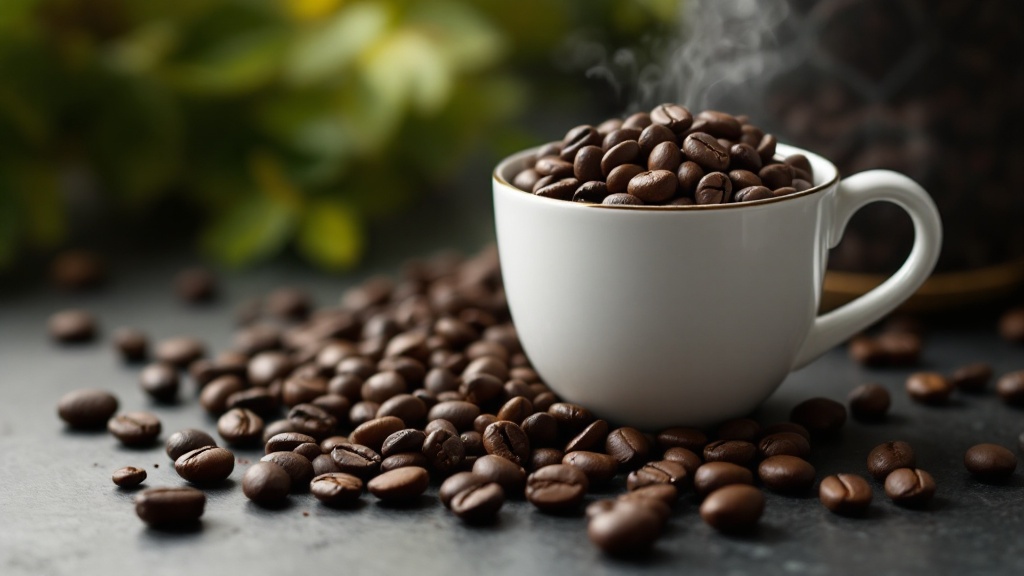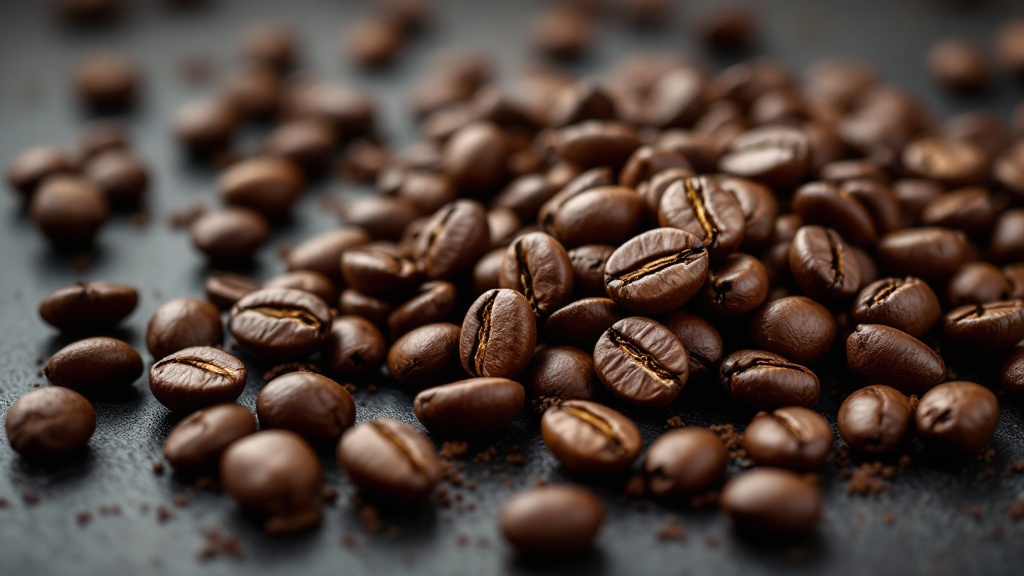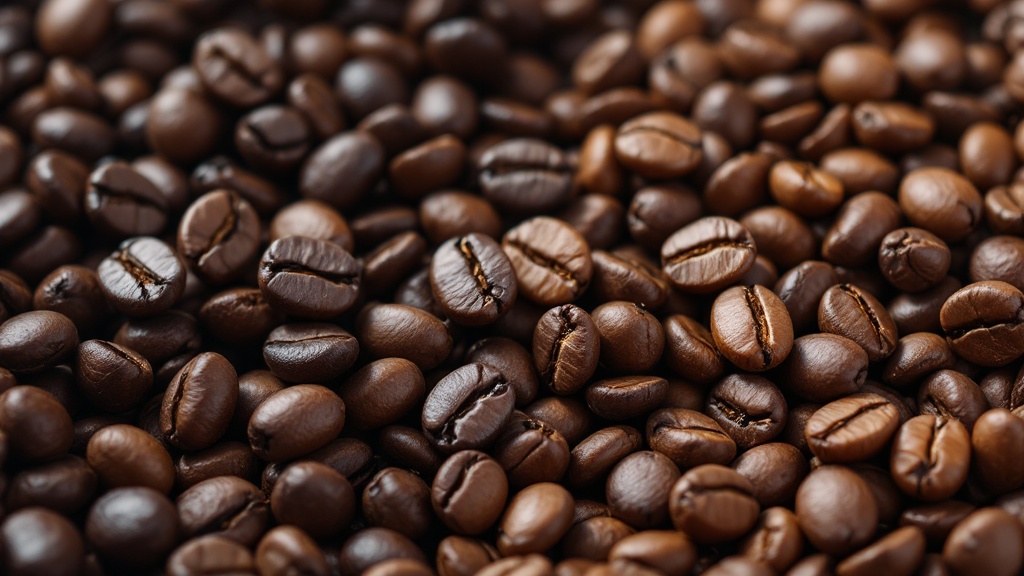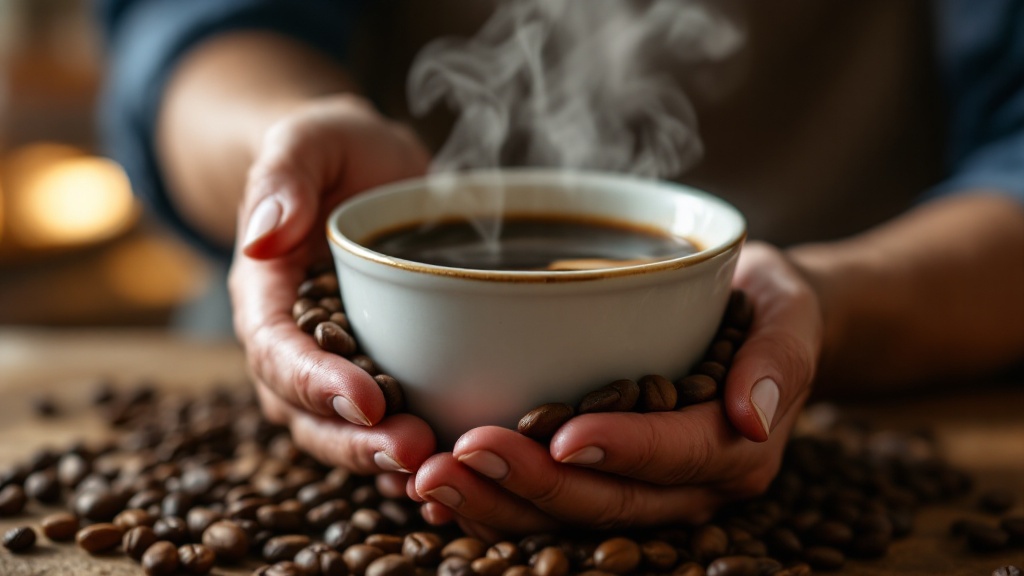1. Introduction

Dark roast and espresso. Two terms often used interchangeably in the coffee world, yet they represent distinct concepts. This confusion leaves many coffee lovers wondering about the real differences. This blog post aims to clarify the distinction between dark roast and espresso, explore best practices for both, and equip you with actionable insights to elevate your coffee experience.
Roast Degree & Bean Origin
The distinction between dark roast and espresso lies primarily in the roasting process and, to a lesser extent, bean origin selection. Dark roast is a descriptor of the roasting *degree*, achieved through extended roasting times and higher temperatures. This process significantly reduces moisture content, resulting in a darker color, altered chemical composition, and a characteristically bold, often bitter, flavor profile. The Maillard reaction, a chemical process responsible for many of coffee’s flavor compounds, is pushed to its furthest extent in dark roasting, leading to the development of pyrazines and other compounds contributing to its robust taste. However, extended roasting can also char the beans, potentially resulting in acrid flavors if overdone. The specific roast level is often denoted using the Agtron scale, a colorimetric system for measuring bean color. A dark roast might register readings below 30 on this scale.
“Dark roast defines the roast level, while espresso is a brewing method–understanding both unlocks the art of crafting exceptional coffee.”
– James Hoffmann, World Barista Champion and Coffee Expert
1. Introduction
2. What Are Dark Roast Coffee Beans?
3. What Are Espresso Coffee Beans?
4. Key Differences Between Dark Roast and Espresso Coffee Beans
5. How to Choose the Right Beans for Your Brew
6. Tools and Techniques for Brewing the Perfect Cup
7. Common Challenges and How to Overcome Them
8. Benefits and Considerations
9. Expert Recommendations for Coffee Lovers
10. Related Topics and Applications
11. Practical Tips for Coffee Enthusiasts
12. Conclusion
13. Additional Resources
Elevate Your Coffee Ritual: Mastering the Bean
- Bean moisture content drastically decreases during the dark roast process, impacting flavor and body.
- The Maillard reaction creates pyrazines, contributing to the characteristic bold and sometimes bitter taste.
- Over-roasting can lead to acrid, burnt flavors; precise control of time and temperature is crucial.
- Agtron scale measurements below 30 typically indicate a dark roast coffee bean.
- Different bean origins can influence the final flavor profile even within the dark roast category.
- Dark roasts often mask the nuances of origin, unlike lighter roasts which better highlight terroir.
| Key Aspect | Roast Degree | Flavor Profile | Agtron Scale |
|---|---|---|---|
| Dark Roast | Extended roasting, higher temperatures | Bold, bitter, robust | Below 30 |
2. What Are Dark Roast Coffee Beans?

Dark roast coffee beans
are roasted longer, typically to the second crack or beyond. This extended roasting process results in a dark brown or black color, an oily surface, and a distinctive flavor profile. The flavor is often described as bold, smoky, or even bitter, with significantly reduced acidity compared to lighter roasts.
“Dark roast coffee beans, with their bold, smoky flavors and low acidity, are a testament to the art of roasting–transforming beans into a rich, versatile brew.”
– James Hoffmann, World Barista Champion and Coffee Expert
This bold flavor profile makes dark roast beans versatile for various brewing methods, including espresso, drip, and French press.
Bean Surface Oils & Maillard Reaction
The oily surface characteristic of dark roast coffee beans is a direct result of the extended roasting process and the Maillard reaction. During roasting, the beans undergo significant chemical changes, including the degradation of sugars and the polymerization of amino acids. This process, known as the Maillard reaction, is responsible for the development of the characteristic dark color and a complex array of flavor compounds. The longer roasting time for dark roasts pushes the Maillard reaction further, leading to the increased formation of melanoidins, which are high-molecular-weight, brown-colored polymers contributing to the oily sheen. This oil is not simply excess bean fat, but rather a complex mixture of these melanoidins and other reaction byproducts.
- The oil consists primarily of melanoidins, complex polymers formed during the Maillard reaction, not simply bean fat.
- The intensity of the oily sheen directly correlates with the roast level; lighter roasts exhibit less oil.
- Acids and other volatile compounds, produced alongside melanoidins, contribute to the coffee’s aroma and flavor profile.
- Pyrolysis, a high-temperature decomposition, also occurs during dark roasting, contributing to oil formation and characteristic flavors.
- These oils contribute to the coffee’s mouthfeel and body, adding to the overall sensory experience.
3. What Are Espresso Coffee Beans?

It’s important to understand that “espresso beans” isn’t a specific type of bean. Instead,
espresso
refers to a brewing method that uses finely ground coffee and high-pressure hot water extraction. While any roast level can be used for espresso, darker roasts are often preferred for their robust flavor, which complements the concentrated brewing process. Espresso results in a rich, concentrated beverage with a layer of crema on top.
According to the Specialty Coffee Association (SCA, 2023), espresso-based drinks dominate coffee shop sales globally, accounting for 60%.
Espresso Extraction Pressure
The pressure profile during espresso extraction significantly impacts the final beverage’s quality. Optimal extraction relies on maintaining a consistent pressure range between 9 and 10 bars (approximately 130-145 psi) throughout the brewing process. Falling below this range results in under-extraction, characterized by sourness, weakness, and a lack of body. Conversely, exceeding this range can lead to over-extraction, manifesting as bitterness, astringency, and a burnt or acrid taste. The pressure is generated by a pump within the espresso machine, and its consistency is crucial for reproducibility. Variations in pressure can be caused by pump malfunctions, inconsistent water supply, or blockages in the group head.
- Pressure gauges help monitor extraction pressure, allowing baristas to make adjustments.
- Pre-infusion, a gentler initial pressure, helps saturate the coffee grounds evenly before full pressure extraction.
- Scale buildup in the group head or pump can significantly impact pressure consistency.
- Different espresso machine types (e.g., lever, pump) can have varying pressure profiles.
- A bottomless portafilter allows visual assessment of extraction, providing clues about pressure inconsistencies.
4. Key Differences Between Dark Roast and Espresso Coffee Beans

The core difference lies in the distinction between roast level and brewing method.
Dark roast
describes the extent to which the beans are roasted, while
espresso
describes how the coffee is brewed.
While dark roast beans are commonly used for espresso, it’s a misconception that espresso
requires
dark roast. Lighter roasts can also be used, resulting in a brighter, more acidic espresso.
Roast Degree’s Impact on Espresso Extraction
The degree of roast significantly influences the espresso extraction process, primarily by altering the bean’s physical and chemical properties. Darker roasts exhibit a higher density due to the significant loss of moisture and the expansion and contraction cycles during roasting. This increased density leads to a slower extraction rate during espresso brewing. The finer grind size often employed with dark roasts further contributes to this slower extraction, necessitating adjustments to brewing parameters such as pressure and time to achieve optimal results. For example, a dark-roasted Sumatran Mandheling might require a longer extraction time to fully develop its flavor profile compared to a lighter-roasted Ethiopian Yirgacheffe. Failure to account for this density difference can result in under-extracted espresso (sour and weak) or over-extracted espresso (bitter and astringent).
- Lighter roasts generally have a faster extraction rate due to lower density and increased porosity.
- Grind size adjustment is crucial; darker roasts often require a coarser grind than lighter roasts to compensate for density.
- Bean origin also influences extraction; dense beans like Indonesian Mandheling require different parameters than lighter, less dense beans from Ethiopia.
- Water temperature can affect extraction time; slightly higher temperatures may be needed for darker roasts to compensate for slower extraction.
- Over-extraction in dark roasts can lead to a burnt, acrid taste, distinct from the bitterness of over-extracted lighter roasts.
5. How to Choose the Right Beans for Your Brew

For Dark Roast Lovers:
If you enjoy the bold, smoky notes of dark roast, consider single-origin dark roasts from regions like Sumatra or Ethiopia for drip or French press brewing. Blended dark roasts are also a good option for a balanced flavor profile.
For Espresso Enthusiasts:
While dark roasts are traditional for espresso, experimenting with medium-dark roasts can provide a pleasing balance between the rich body of espresso and the nuanced flavors of the bean’s origin. As coffee expert James Hoffmann recommends, a medium-dark roast can be an excellent choice for espresso.
Roast Level & Espresso Extraction
The relationship between roast level and espresso extraction is complex, significantly influencing the final cup’s quality. Dark roasts, while traditionally favored for espresso due to their perceived robustness, present challenges. The extended roasting process develops melanoidins and reduces the bean’s density, potentially leading to over-extraction and bitter, astringent flavors. This is because the longer roasting time alters the bean’s cellular structure, increasing the surface area available for water contact during brewing. This accelerated extraction can overwhelm delicate flavor notes, masking the subtleties of origin characteristics. The resulting espresso may exhibit a burnt or acrid taste, lacking nuanced acidity and sweetness.
- Lighter roasts often yield brighter acidity and nuanced flavor profiles, showcasing origin characteristics better than darker roasts.
- The Maillard reaction, prominent in the early stages of roasting, contributes desirable sweetness and aroma compounds that can be lost in darker roasts.
- Over-extraction in dark roasts can lead to a shorter-lived crema, impacting the visual and textural experience of the espresso.
- Bean density plays a crucial role; less dense, darker roasted beans extract faster, requiring adjustments in grind size and brew time.
- Finding the optimal roast level is crucial for balancing desirable characteristics like body, sweetness, and acidity.
6. Tools and Techniques for Brewing the Perfect Cup

Essential Tools:
- Espresso machine (e.g., Breville, La Marzocco)
- Burr grinder for consistent grind size
- Scale for precise measurements
Brewing Techniques:
- Grind size: Fine (like table salt) for espresso, medium-coarse for dark roast drip
- Extraction time: 25-30 seconds for espresso, 4-5 minutes for French press
- Water temperature: 90-96°C (195-205°F)
Actionable Insight:
For espresso, aim for a 1:2 coffee-to-water ratio (e.g., 18g coffee to 36g water).
Espresso Extraction Yield
Achieving optimal espresso extraction relies heavily on achieving the correct extraction yield, typically expressed as a percentage. This represents the ratio of brewed espresso to the initial mass of coffee grounds. A target range of 18-22% is generally considered ideal, although this can vary slightly based on bean characteristics and desired flavor profile. Extraction yield below this range indicates under-extraction, resulting in a sour, under-bodied espresso with noticeable acidity and a lack of sweetness. Conversely, over-extraction (above 22%) leads to a bitter, astringent, and burnt taste, often accompanied by a heavy mouthfeel. Precise measurement of the extraction yield requires a scale capable of measuring grams to 0.1g accuracy, both for the initial dose of coffee and the final espresso yield.
- Extraction time significantly impacts yield; a longer extraction often results in higher yield but may lead to over-extraction.
- Grind size is crucial; finer grinds generally increase yield but risk over-extraction if not managed carefully.
- Water temperature plays a role; higher temperatures can slightly increase extraction yield.
- Coffee bean origin and roast level influence the ideal extraction yield range.
- Using a bottomless portafilter allows visual assessment of extraction, helping to refine technique and achieve target yield.
- Even distribution of coffee grounds in the portafilter is essential for consistent extraction across the puck.
7. Common Challenges and How to Overcome Them

Over-Extraction:
- Symptoms: Bitter taste
- Solution: Use a coarser grind or reduce extraction time
Under-Extraction:
- Symptoms: Sour taste
- Solution: Use a finer grind or increase extraction time
Channeling:
Preventing Channeling Effects
Channeling, a significant impediment to efficient extraction in various processes (e.g., solvent extraction, leaching, chromatography), arises from preferential flow pathways within the extraction medium. This non-uniform flow leads to incomplete extraction, reduced yield, and inconsistent product quality. The phenomenon is governed by factors such as particle size distribution, bed porosity, and fluid viscosity. Inconsistent packing of the extraction bed, with larger particles creating preferential pathways, is a major contributor. Furthermore, variations in particle shape and size lead to increased void space and reduced contact efficiency between the solvent and the target material, exacerbating channeling.
- Symptoms: Uneven extraction, watery espresso
- Solution: Ensure even tamping and proper grind distribution. Barista champion Matt Perger recommends using a distribution tool.
- Uniform particle size reduces void spaces, minimizing preferential flow paths.
- Pre-infusion helps saturate the coffee bed, reducing initial channeling tendencies.
- Using a coarser grind can help mitigate channeling in cases of overly fine grinds.
- Proper bed preparation, including leveling and tamping, creates a more consistent density.
- Different extraction methods (e.g., immersion) inherently reduce channeling effects.
8. Benefits and Considerations

Dark Roast Benefits:
- Bold, intense flavor
- Lower acidity, easier on sensitive stomachs
Espresso Benefits:
- Concentrated flavor and aroma
- High caffeine content per ounce
Considerations:
Espresso Extraction Optimization
Achieving optimal espresso extraction relies heavily on precise control of several key parameters. The most critical factors include grind size, dose (input mass of coffee), and brew ratio (ratio of coffee mass to espresso yield). Grind size directly impacts the surface area available for water extraction; too coarse a grind results in under-extraction, characterized by weak, sour espresso, while too fine a grind leads to over-extraction, resulting in bitter and astringent flavors. Precise control is often achieved using burr grinders with adjustable settings, allowing for fine-tuning based on bean characteristics and desired extraction profile. For instance, a lighter roast might require a slightly finer grind than a darker roast to achieve a balanced extraction.
- Dark roasts may mask subtle origin flavors
- Espresso requires specialized equipment and practice
- Water temperature significantly impacts extraction; ideal range is 195-205°F (90-96°C).
- Brew pressure is crucial; a typical range is 9-10 bars for optimal extraction.
- Tamping pressure should be consistent around 30 lbs for even water distribution.
- Extraction time typically falls between 25-30 seconds for a balanced shot.
- Using a scale for precise measurements of coffee dose and espresso yield is essential.
- Regular grinder calibration is needed to maintain consistent particle size.
9. Expert Recommendations for Coffee Lovers

According to experts like James Hoffmann, here are some key recommendations:
Optimal Coffee Extraction Yield
Achieving optimal coffee extraction yield is paramount for a superior cup. This involves maximizing the dissolved solids from the coffee grounds while minimizing undesirable compounds that contribute to bitterness or astringency. The extraction yield, typically expressed as a percentage, represents the ratio of dissolved solids to the total mass of coffee grounds. A generally accepted target range for optimal extraction yield is between 18% and 22%, though this can vary slightly depending on the specific coffee bean’s characteristics and the brewing method employed.
Choose Fresh Beans:
Use beans within 2-4 weeks of roasting for optimal flavor.
Experiment with Roasts:
Don’t be afraid to try different roast levels to find your preference.
Invest in Quality Equipment:
A good burr grinder and espresso machine are worthwhile investments.
Practice Consistency:
Pay close attention to grind size, dose, and tamping pressure.
Learn Dialing-In:
Experiment with different variables to fine-tune your espresso to your liking.
- TDS (Total Dissolved Solids) measurement is crucial for precise yield determination.
- Under-extraction results in sour, weak coffee; over-extraction leads to bitter, astringent flavors.
- Factors like water temperature and brew time significantly impact extraction yield.
- A refractometer provides accurate TDS readings for consistent brewing.
- The ideal extraction range can shift slightly based on bean origin and processing methods.
- Keep detailed brewing notes to track your experiments and optimize your process.
10. Related Topics and Applications

Related Topics:
- Coffee Roasting Techniques
- Brewing Methods (AeroPress, French Press, Pour-Over)
- Latte Art and Milk Steaming
- Home brewing for coffee enthusiasts
- Specialty coffee shops and cafes
- Pairing coffee with food (e.g., dark roast with chocolate desserts)
- Utilizes Kafka’s distributed, fault-tolerant architecture for high availability and scalability.
- Supports various stream processing patterns like windowing, joins, and aggregations through its DSL.
- Offers exactly-once processing semantics ensuring data accuracy and consistency.
- Integrates seamlessly with other Kafka ecosystem tools like Kafka Connect and Kafka Connect.
- Enables building microservices for efficient, independent data processing units.
- Provides monitoring and management tools for observing application health and performance.
11. Practical Tips for Coffee Enthusiasts

Optimizing Coffee Extraction Yield
Achieving optimal coffee extraction involves precise control over several key variables impacting the final brew’s quality. A crucial factor is the extraction yield, representing the percentage of soluble solids extracted from the coffee grounds during brewing. Ideally, this yield should fall within the range of 18-22%, depending on the bean’s origin, roast level, and desired flavor profile. Yields below this range often result in under-extracted coffee, characterized by sourness and lack of body, while yields above this range lead to over-extraction, resulting in bitterness and astringency. Precise measurement of extraction yield requires specialized equipment such as a refractometer, measuring the total dissolved solids (TDS) in the brewed coffee, and a scale to measure the total brewed coffee mass.
Storage:
Store beans in an airtight container away from light, heat, and moisture.
Tasting:
Use a flavor wheel to explore the nuances of dark roasts and espresso.
Cleaning:
Regularly clean your espresso machine to prevent buildup and maintain optimal flavor.
- Extraction yield is influenced by grind size; finer grinds generally lead to higher yields.
- Water temperature significantly impacts extraction; ideal range is typically between 195-205°F (90-96°C).
- Brew time is another critical variable; longer brew times often result in higher extraction yields.
- Coffee-to-water ratio affects the final concentration and thus the perceived extraction.
- Using a refractometer allows for precise measurement, enabling adjustments for optimal flavor.
- Different brewing methods (e.g., pour over, espresso) have different optimal extraction yield ranges.
12. Conclusion

Dark roast and espresso, while often confused, are distinct concepts related to coffee. Dark roast refers to the bean’s roast level, while espresso describes a brewing method. By understanding these differences, exploring various roast levels, mastering essential techniques, and investing in quality equipment, you can unlock a world of rich, flavorful coffee experiences. What’s your favorite way to enjoy dark roast or espresso? Share your thoughts in the comments!
Espresso Extraction Parameters
Espresso extraction is a complex process heavily reliant on precise control of several key parameters. The most significant are grind size, dose (amount of ground coffee), tamp pressure, and brew time. Grind size directly impacts the surface area of the coffee grounds exposed to the hot water; too coarse a grind results in under-extraction, yielding a weak, sour brew, while too fine a grind leads to over-extraction, producing a bitter, astringent result. Optimal grind size is often dependent on the specific coffee bean, its roast level, and the espresso machine’s capabilities. A burr grinder is essential for consistent particle size distribution, a crucial factor in achieving repeatable extractions. For example, a Baratza Sette 270Wi grinder provides the precision needed to dial in the ideal grind settings.
- Water temperature significantly impacts extraction; ideal range is 195-205°F (90-96°C).
- Dose and brew time are interconnected; a larger dose generally requires a longer extraction time.
- Tamp pressure should be consistent around 30 pounds per square inch (PSI) for even extraction.
- Pre-infusion (a short period of low-pressure water) can improve extraction and reduce channeling.
- Espresso machine type influences parameters; different machines have varying pressure profiles.
- Regular maintenance, like cleaning the portafilter and grinder, is crucial for consistent results.
13. Additional Resources

- The authorization code grant type is best for server-side apps, maintaining client secrets securely.
- After authorization, the server receives a code, exchanged for an access token at the token endpoint.
- Refresh tokens extend access without repeated user authentication; consider their secure storage.
- Scope defines the level of access granted (e.g., `profile`, `email`, `write:posts`).
- Implement proper error handling for authorization failures and token expiry scenarios.
- Consider using libraries like `requests-oauthlib` (Python) or similar for easier integration.
Elevate Your Coffee Ritual: Mastering the Bean

Roast Level & Bean Density
The relationship between roast level and bean density significantly impacts the final cup’s flavor profile and extraction. Darker roasts, achieved through extended roasting times and higher temperatures, exhibit a lower bean density due to the expansion and degassing of volatile compounds. This reduced density translates to a larger surface area per unit of mass, potentially leading to over-extraction if not accounted for during brewing. Conversely, lighter roasts maintain a higher density, resulting in a slower extraction rate and potentially requiring longer brew times or finer grinds to achieve optimal extraction. This difference is crucial when applying precision brewing methods.
So, the next time you find yourself standing before a wall of coffee beans, remember this: “dark roast” refers to the color and flavor profile imparted by the roasting process, while “espresso” denotes a brewing method. Dark roasts, with their bold, smoky notes and low acidity, are often favored for espresso but can be enjoyed through various brewing methods. Conversely, espresso, with its concentrated richness and crema, can be created using beans of any roast level, although lighter roasts may require adjustments to grind size and brewing time to achieve optimal extraction. Understanding this fundamental difference empowers you to choose the perfect beans and brewing method to suit your individual palate.
By recognizing the distinct qualities of dark roasts and the versatility of the espresso method, you can unlock a new level of coffee appreciation. Experiment with different roast levels in your espresso machine, or explore alternative brewing methods for your favorite dark roast beans. The world of coffee is vast and full of exciting possibilities. This knowledge equips you to navigate the nuances of coffee with confidence and finesse, ultimately curating the perfect cup every time.
Now, go forth and brew extraordinary coffee. Your perfect cup awaits.
“`
- Dark roasts often have a more porous structure, increasing their susceptibility to channeling during brewing.
- Lighter roasts generally contain more density and require a finer grind size for adequate extraction.
- Bean density variations influence the rate at which water penetrates the coffee grounds, impacting the brewing time.
- The choice of grind size should be adjusted based on both roast level and desired brew strength.
- Over-extraction in darker roasts can lead to bitterness, while under-extraction in lighter roasts results in sourness.
- Using a scale to measure coffee grounds helps control the coffee-to-water ratio, particularly crucial with varying bean densities.
| Key Aspect | Roast Level | Bean Density | Extraction Impact |
|---|---|---|---|
| Darker Roasts | Extended roasting, higher temps | Lower density, porous structure | Risk of over-extraction, bitterness |
| Lighter Roasts | Shorter roasting, lower temps | Higher density, finer grind needed | Risk of under-extraction, sourness |
| Brewing Adjustment | Adjust grind size | Control coffee-to-water ratio | Optimize extraction time |

